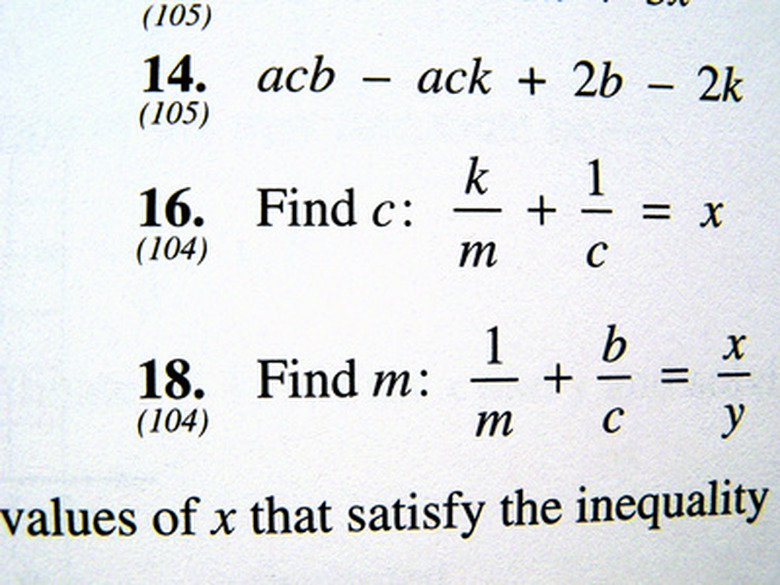How To Add & Subtract Fractions With Monomials
Monomials are groups of individual numbers or variables that are combined by multiplication. "X," "2/3Y," "5," "0.5XY" and "4XY^2" can all be monomials, because the individual numbers and variables are combined only using multiplication. In contrast, "X+Y-1" is a polynomial, because it is comprised of three monomials combined with addition and/or subtraction. However, you can still add monomials together in such a polynomial expression, as long as they are of like terms. This means they have the same variable with the same exponent, such as "X^2 + 2X^2". When the monomial contains fractions, then you would add and subtract like terms as normal.
Step 1
Set up the equation you would like to solve. As an example, use the equation:
1/2X + 4/5 + 3/4X – 5/6X^2 – X + 1/3X^2 -1/10
The notation "^" means "to the power of," with the number being the exponent, or the power to which the variable is raised.
Step 2
Identify the like terms. In the example, there would be three like terms: "X," "X^2" and numbers without variables. You cannot add or subtract unlike terms, so you might find it easier to rearrange the equation to group like terms. Remember to keep any negative or positive signs in front of the numbers you move. In the example, you might arrange the equation like:
(1/2X + 3/4X – X) + (4/5 – 1/10) + (-5/6X^2 + 1/3X^2)
You can treat each group like a separate equation since you cannot add them together.
Step 3
Find common denominators for the fractions. This means that the bottom part of each fraction you are adding or subtracting must be the same. In the example:
(1/2X + 3/4X – X) + (4/5 – 1/10) + (-5/6X^2 + 1/3X^2)
The first part has denominators of 2, 4 and 1, respectively. The "1" isn't shown, but can be assumed as 1/1, which doesn't change the variable. Since both 1 and 2 will go into 4 evenly, you can use 4 as the common denominator. To adjust the equation, you would multiply 1/2X by 2/2 and X by 4/4. You may notice that in both cases, we are simply multiplying with a different fraction, both of which reduces to just "1," which again doesn't change the equation; it just converts it into a form you can combine. The end result would therefore be (2/4X + 3/4X – 4/4X).
Likewise, the second part would have a common denominator of 10, so you would multiply 4/5 by 2/2, which equals 8/10. In the third group, 6 would be the common denominator, so you could multiply 1/3X^2 by 2/2. The end result is:
(2/4X + 3/4X – 4/4X) + (8/10 – 1/10) + (-5/6X^2 + 3/6X^2)
Step 4
Add or subtract the numerators, or the top of the fractions, to combine. In the example:
(2/4X + 3/4X – 4/4X) + (8/10 – 1/10) + (-5/6X^2 + 3/6X^2)
Would be combined as:
1/4X + 7/10 + (-2/6X^2)
or
1/4X + 7/10 – 2/6X^2
Step 5
Reduce any fraction to its smallest denominator. In the example, the only number that can be reduced is -2/6X^2. Since 2 goes into 6 three times (and not six times), it can be reduced to -1/3X^2. The final solution is therefore:
1/4X + 7/10 – 1/3X^2
You can rearrange again if you like descending exponents. Some teachers like that arrangement to help avoid missing like terms:
-1/3X^2 + 1/4X + 7/10
References
Cite This Article
MLA
Taylor, C.. "How To Add & Subtract Fractions With Monomials" sciencing.com, https://www.sciencing.com/add-subtract-fractions-monomials-7710425/. 24 April 2017.
APA
Taylor, C.. (2017, April 24). How To Add & Subtract Fractions With Monomials. sciencing.com. Retrieved from https://www.sciencing.com/add-subtract-fractions-monomials-7710425/
Chicago
Taylor, C.. How To Add & Subtract Fractions With Monomials last modified March 24, 2022. https://www.sciencing.com/add-subtract-fractions-monomials-7710425/
